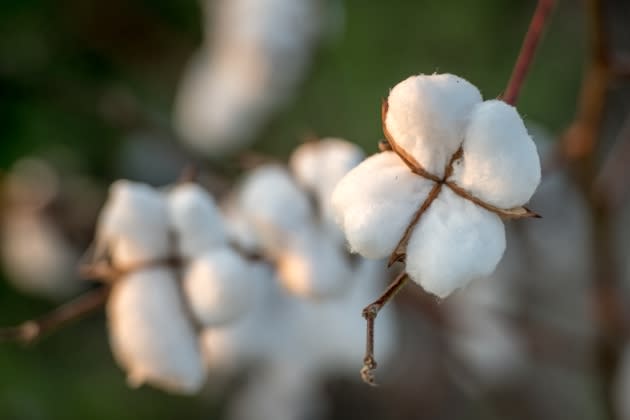Cotton Forecast Points to Price Stability, Record Yields

The global cotton picture is picking up after three years suffering under La Niña weather conditions and the toll its cooler temperatures took on crop yields, according to Antonia Prescott, deputy editor of Cotton Outlook, the trade publication covering the worldwide cotton industry.
Over the past 12 months, U.S. harvests were looking grim and forecasters were not optimistic about how and when it would reverse course. In West Texas for example, where 50 percent of U.S. cotton crops are grown, some 70 percent of cotton planted fell to abandonment at one point. That means that almost three-quarters of the cotton that was planted was not harvested.
More from Sourcing Journal
It turned itself around in the end, however, Prescott said in an interview with Sourcing Journal editor in chief Peter Sadera for Sourcing Journal’s Global Outlook event. If conditions remain favorable, according to Prescott, the U.S. crop will be 16.5 million bales this year, up from 14.5 million bales a year ago.
Australia and Brazil have also rallied, the latter producing a record 3 million tons of cotton. Australia produced 5.5 million bales, after the three-year drought, also the country’s largest crop on record.
Pakistan’s biggest problem over the past year was not drought but massive floods last August that could have dealt a destructive blow to the yield of the fifth-largest cotton-growing nation. But it too managed to escape relatively unscathed. Ten months after the floods, the prospects are deemed good thanks to land regained from competing crops.
India, on the other hand, has plateaued and is now officially in decline, according to Prescott. It has the largest planted area, 11.5-13 million hectares, but uneven climate patterns are causing uncertainty over the size of the crop. The rainfall is normally uneven, but now a late monsoon season is adding to the problem.
Output in India is measured in the amount of seed cotton delivered weekly or daily to gins, which usually peaks over the season then evens out. There was no peak this year, leading observers to predict a decline in total output that never materialized. Total yield in India this growing season was 30 million Indian bales, which weigh 170 kg. each (U.S. bales weigh 226.8 kg. or 500 lbs. each).
“It is true that output is smaller than first estimated last spring but extended arrivals means production is now proving to be 30 million bales,” Prescott said. “It’s not as bad as it was feared a few months ago.”
India has the lowest yields of any major cotton producer, according to Prescott, who attributed that to seed quality. Farmers use Indian GMO seed, which contains a great deal of counterfeit seed that has a negative impact on yield. She noted that it would not take much to improve the yield over 13 million hectares, which is the goal of the newly formed government agency, the Textiles Advisory Group, whose first order of business will be to tackle the seed problem.
Prices collapsed last November to between about 97 cents to 105 cents per pound, according to the ‘A’ Index, Prescott said. In her view, the issue is pressure at both ends, the costs to farmers of labor and energy, the latter exacerbated by the invasion of Ukraine by Russia, causing fuel and fertilizer shortages all around.
On the opposite end is a dearth of demand from consumers and retailers, especially in the U.S. and Europe, the two powerhouses of apparel consumption. Prescott noted how orders are few in number and low in price.

Prices to spinners are low and falling, she noted, but traders in the middle are still doing business while waiting for the standoff to break. Mills, meanwhile, are buying on a hand-to-mouth basis.
Yet, she said, a shift is inevitable. Huge crops from Australia and Brazil will eventually hit the market and things will start to even out. She noted comparisons between the current market and what she called the two-year “bull run,” 2020-2022, when cotton prices rose dramatically. They started to go up in response to the U.S. Federal Reserve flooding the market with cheap money to stimulate the economy worldwide, then real cotton price discovery took over.
The crash came eventually. Investment firms got out of their long positions in those commodities, forcing prices into a downward spiral. Cotton Outlook’s ‘A’ Index lost 50 percent of its value in six months, Prescott recalled. Consumers came out of lockdown to massive inflation, causing them to change their financial priorities. “Eventually, the normal rules of supply and demand are brought to bear,” she said.

